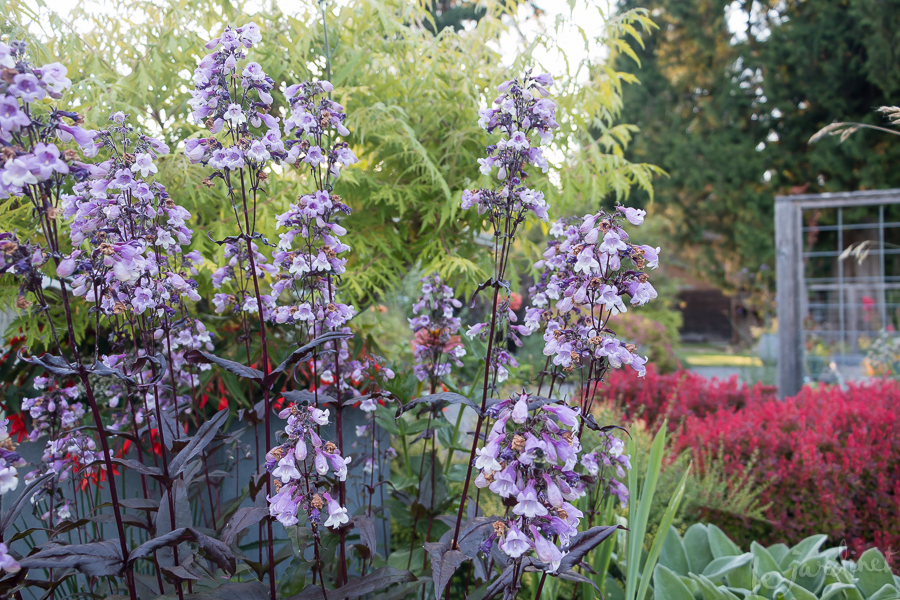Connecting Garden Beds with Color

We all have areas in our garden that pose a significant design challenge. Such is the case with this bijou bed adjacent to our main patio. It is seen from the kitchen windows year-round yet is part of a 5-acre landscape with much larger sweeping borders. Measuring approximately 12 feet square with a central container as a focal point, this does pose a few significant challenges.
Design Challenges

Within feet of the kitchen and patio there is no room to hide! Everything has to work and earn its place. The reality of vole and slug damage has to be mitigated. Rather than show you a "fluffed and buffed" garden bed – this is real life, with damage, fading flowers and more. Yet it is still colorful and interesting.
- Make it interesting enough to be viewed up close without resembling a collection of random plants
- Tie it into the larger landscape design which features bold sweeps of plants and color
- Bring four season interest as well as blasts of unapologetic summer color to enjoy from our patio
Site Conditions
- Soil is sticky clay in parts and generally saturated in winter due to a perched water table so not great for typical drought tolerant plants, yet…
- Full sun
- No irrigation except for the container, so everything must be drought tolerant once established
- Prone to damage by deer, rabbits, voles and slugs….. and a dog chasing the rabbits
Solutions

The slender flower stalks of blue oat grass creates a tantalizing glimpse of the treasures beyond. Yes, the rabbits chewed the one on the right so its not quite as big…but that's gardening. The deep burgundy foliage of a Red Dragon corkscrew hazel in an adjacent bed repeats the color of a compact Midnight Wine weigela and Blaze of Fulda sedum, visially connecting the two spaces.
Color Scheme
When considering an overall color scheme I think in broad strokes rather than specifics. Most of my garden has a "sunset" color scheme, which gives me a lot of creative license to include shades of pink and orange as well as midnight blue-purple if I wish to. This in turn stops everything getting too matchy-matchy and gives serendipity a chance. It's also important to avoid a color scheme which is all high contrast. So chartreuse and purple get tempered with blue-green and silver adds a fun youthfulness.
Color Echoes
I repeat colors used in the larger landscape in this small bed such as shades of burgundy, gold, purple, silver and blue, which provides a sense of cohesion even if the same plants are not always repeated.
Foliage First

Most of the color seen here comes from foliage – and echoes the colors seen in the distant border. The variegated sedum has to be sprayed with deer-repellent but otherwise there's nothing here to interest the deer that walk past every day
As always, I use the color of foliage to anchor the design even in small spaces so that I'm not constantly waiting for things to bloom or disappointed when they have finished flowering. I also vary the texture of plants, their shape, and their height for visual interest. I especially like using the grasses to create an ethereal scrim effect.
Plants used (this year!)
Shrubs
Tiger Eyes sumac (in container)
Perennials

Bees love this penstemon! The deep colored foliage is also a huge plus. It has now started to produce a few extra seedlings which I'm thrilled about.
Denim 'n' Lace Russian sage (not in bloom yet)
Arizona Sun blanket flower (not in bloom yet)
Annuals

Easy to grow from seed, these compact zinnia pack a lot of color into a small space. The red disc echoes the color of the sedum foliage wile the cool blue of Cats Pajamas catmint tempers the heat
Silver Bullet wormwood (although this has overwintered….but I now have to cut off the flowers to keep it tidy)
Red/yellow bicolor zinnia (grown from seed)
Apricot Blush zinnia (grown from seed)
Asian Garden celosia (grown from seed)
Bonfire begonia (in container)
Diamond Frost euphorbia (in container)
Subscribe to Receive Blog Posts
Gardening inspiration delivered right to your inbox from Le Jardinet
Karen,
What a feast for the eyes! Here in north Florida I wonder what kind of summer we’ll have. Almost three weeks of near drought to start June, and now cooler, raining, and a notch shy of resplendent. Since I can’t control that I marvel at your outcomes.
The image below “Foliage First” strikes me as your thesis on successful use of foliage. Bravo!
Connecting nearby beds to background colors gives me a sense of flow and continuity. Without redundancy. Very enjoyable.
Thank you so much for your kind feedback Gary – so glad you enjoyed the post. I must admit, having just see the forecast for the next week I may be on triage for a while!!